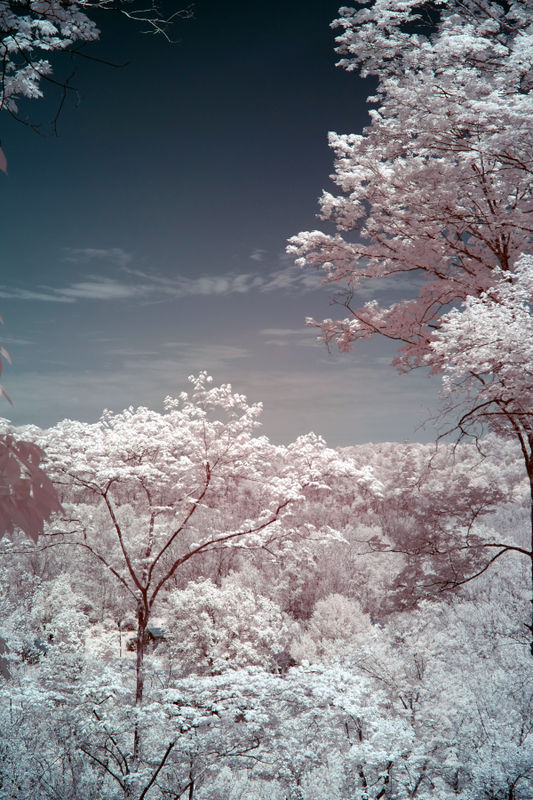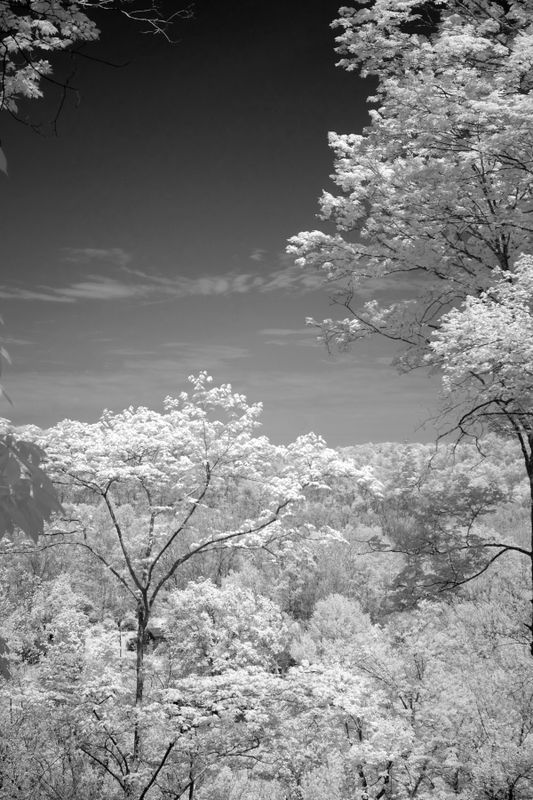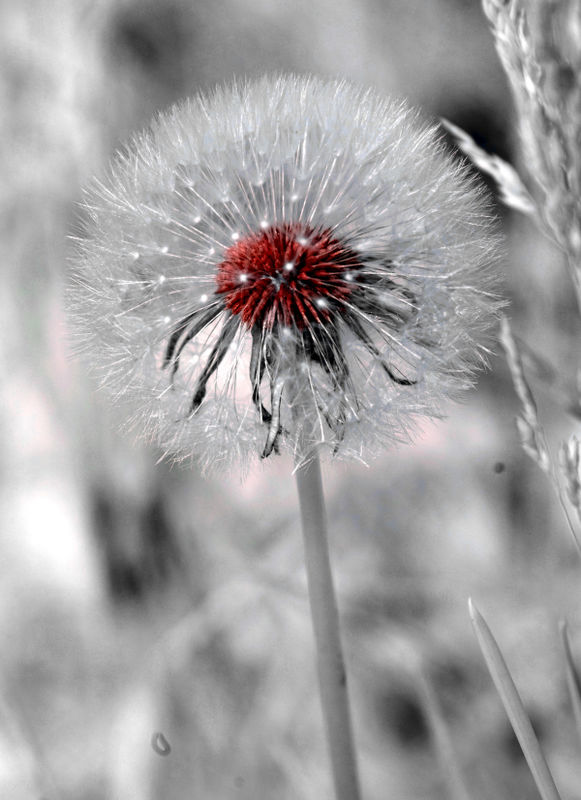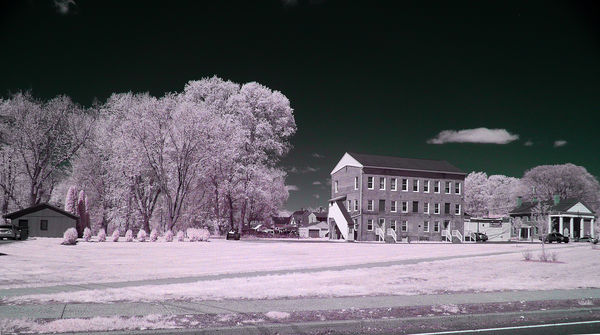Infrared, anybody?
May 1, 2019 21:58:01 #
[quote=JohnSwanda]I used to shoot a lot of B&W infrared film in 35mm and 4x5.
Stunning!!!Surrealistic!!!Fantastic blue sky!! Thank you for sharing the information,and the photos!!
👍👍👍👍👍
annie
Stunning!!!Surrealistic!!!Fantastic blue sky!! Thank you for sharing the information,and the photos!!
👍👍👍👍👍
annie
May 1, 2019 22:27:26 #
depscribe wrote:
What does full spectrum bring as opposed to, say, a 590nm IR conversion? With the X-E2 I have 720nm natively after conversion, and throw an 850 or 950nm filter on for black and white (because of the conversion I can see through the 950, which I wouldn't be able to do, and autofocus would be impossible). What happens if you shoot your full-spectrum camera with no filter?
Good questions!
With a full spectrum, I can pick any filter I want to use, including UV_IR cut filter which turns the camera back into a normal camera. I have used this to prove to myself how the IR image can see through haze, smoke, etc, better than a normal camera by just changing the filter.
And yes, you can add an 850 or 950 on top of the built in 720, but you now are going through two filters. And you can't go to 650 or 590 since the 720 removes those wave lengths.
Plus, I can try orange or yellow, or any other color I choose. But this maybe not as important since Photoshop can simulate these filters.
If I use no filter, the sensitivity of the camera to IR causes the image to look much redder than a normal image. In converting to B&W, it tends to have characteristics of using a red filter, perhaps not as strong.
By the way, with both my cameras, I can see through the filters with both the EVF and with the LCD. Even at 950.
May 2, 2019 07:20:57 #
JohnSwanda wrote:
I used to shoot a lot of B&W infrared film in 35mm and 4x5.
Beautiful! That's what's nice about shooting digital IR - so much leeway to process the colors.
May 2, 2019 07:44:26 #
I frequently shoot infrared on my 720nm LifePixel converted Sony A7R (https://www.izzyfotos.com/infrared) . Depending on the lens I do have hot spots. There is a list on the web somewhere, maybe on Kolari or LifePixel sites, on which lenses have issues. I usually use Khromagery action in PS to swap channels and then optimize the colors to my liking using NIK, Luminar, PS and convert to B&W using PS, if seems appropriate. I try to fix hotspots using local brushes or NIK Viveza.
May 2, 2019 07:50:33 #
Whenever we display photos, especially IR where the choice of filter makes a great difference... the information about the filter and exposure should be stated. There are many who may be interested in IR but always think B&W and do not know about the filters that blend visable with IR.
When taking IR we at 720nm get red sky and blue trees. While some enjoy pain doing channel swapping to show their skill, there is a free switch program that only requires a click. I believe the second link has the program with R/B swap.
http://www.flamingpear.com/freebies.html
http://flamingpear.com/older.html
For those who want to venture into IR for low cost, please read the simple 6 screws for back case 3 screws for the sensor for a Panasonic older camera. The conversion to full spectra is easy and the camera is a small pocket camera and uses a 37mm filter... these small filters are inexpensive.
https://www.uglyhedgehog.com/t-547605-1.html
When taking IR we at 720nm get red sky and blue trees. While some enjoy pain doing channel swapping to show their skill, there is a free switch program that only requires a click. I believe the second link has the program with R/B swap.
http://www.flamingpear.com/freebies.html
http://flamingpear.com/older.html
For those who want to venture into IR for low cost, please read the simple 6 screws for back case 3 screws for the sensor for a Panasonic older camera. The conversion to full spectra is easy and the camera is a small pocket camera and uses a 37mm filter... these small filters are inexpensive.
https://www.uglyhedgehog.com/t-547605-1.html
May 2, 2019 08:25:42 #
Just a quick second to a comment above about IR hotspots. Trying shooting with the largest aperture practical. I had the same problem until I discovered that opening the aperture resolved the issue.
May 2, 2019 10:09:38 #
springlake wrote:
Just a quick second to a comment above about IR hotspots. Trying shooting with the largest aperture practical. I had the same problem until I discovered that opening the aperture resolved the issue.
It does on some but not all lenses. And there's more. The nature of hotspots varies. We're most of us accustomed to the very distinct, often sharp-edged hotspots found with many lenses. But there's an insidious variety that isn't instantly apparent. I encountered it with my 18-135 Fuji lens, which has been reported as just fine for IR and which I got for just that purpose. It has strong color vignetting, producing a red cast toward the center (or a blue cast toward the edges, take your pick). This is the case at all apertures and all focal lengths. And it doesn't especially stand out in black-and-white, which is to say it's easily corrected there, but trying to fix it in color is a real pain. To wit:


May 2, 2019 10:18:58 #
wingclui44
Loc: CT USA
dpullum wrote:
swapWhenever we display photos, especially IR where th... (show quote)
Since getting your advice and converted my P&S to full spectrum IR, I have been getting real fun with that, now I also got a 850nm filter to play with B&W. I do have a couple question to ask you or the other IR experts here. How do I set the correct WB in the camera before shooting? I use a white card to set the WB and the picture comes out from the camera shows colorless, comparing using auto WB, that it comes out pinkish red. So which one is the correct setting? Second question is. on PP, I have only the program of LR and PSel which do not have the ability for channel swap, I do using PSel with color adjustment to play with the color. Too bad, the software company does not offer one time buying program any more and people need to rent their program on monthly basic, so they make more money by hooking you forever.
Here's one shoot with WB set with a white card;
May 2, 2019 10:21:51 #
wingclui44 wrote:
How do I set the correct WB in the camera before shooting?
A good method is to take white balance off of something green -- a patch of grass is good. And it's best to retake your WB from time to time, even during one day's shooting, because IR varies throughout the day and certainly from day to day.
As to software, the GIMP handles IR pretty well (and with plugins will do most RAW stuff, though its specialty is post-RAW processing). And it's free and available for most operating systems.
May 2, 2019 10:26:21 #
sueyeisert
Loc: New Jersey
depscribe wrote:
It's infrared season in North America, and looking... (show quote)
I shoot Fuji. Lens I use is 35 mm 1.4. Also 14 mm,50-200nm and a lot of people say the 18-135mm is good. I’d stick with the 720nm.
May 2, 2019 10:28:13 #
sueyeisert wrote:
I shoot Fuji. Lens I use is 35 mm 1.4. Also 14 mm,50-200nm and a lot of people say the 18-135mm is good.
I've had good luck with the 50-200, but the 18-135 has been a bust for color IR -- see above.
May 2, 2019 11:27:56 #
As with Forrest Gump's mama's chocolates, with IR you never know what you're going to get. This from a few minutes ago in my yard. (Yeah, I know I should mow it.) OOC jpeg but for cyan desaturation in post. (And, of course, channel swap.)

May 2, 2019 12:42:41 #
I was unaware that it was seasonal. I've shot IR throughout the year, depending on the subject matter.
--Bob
--Bob
depscribe wrote:
It's infrared season in North America, and looking... (show quote)
May 2, 2019 12:51:02 #
rmalarz wrote:
I was unaware that it was seasonal. I've shot IR throughout the year, depending on the subject matter.
--Bob
--Bob
Right. No disagreement here. But in the spring there's an abundance of new foliage and thunderstorms, both of which are ripe for infrared photography.
May 2, 2019 13:00:09 #
wingclui44
Loc: CT USA
depscribe wrote:
A good method is to take white balance off of something green -- a patch of grass is good. And it's best to retake your WB from time to time, even during one day's shooting, because IR varies throughout the day and certainly from day to day.
As to software, the GIMP handles IR pretty well (and with plugins will do most RAW stuff, though its specialty is post-RAW processing). And it's free and available for most operating systems.
As to software, the GIMP handles IR pretty well (and with plugins will do most RAW stuff, though its specialty is post-RAW processing). And it's free and available for most operating systems.
Thank you very much! I will look and check the GIMP out! I am still a newbie on IR, I am just try to learn and practice with my P&S and getting more experience, then I will convert my old D200.
If you want to reply, then register here. Registration is free and your account is created instantly, so you can post right away.





